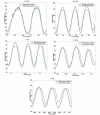Wearable Conductive Fiber Sensors for Multi-Axis Human Joint Angle Measurements
- PMID: 15740632
- PMCID: PMC555561
- DOI: 10.1186/1743-0003-2-7
Wearable Conductive Fiber Sensors for Multi-Axis Human Joint Angle Measurements
Abstract
BACKGROUND: The practice of continuous, long-term monitoring of human joint motion is one that finds many applications, especially in the medical and rehabilitation fields. There is a lack of acceptable devices available to perform such measurements in the field in a reliable and non-intrusive way over a long period of time. The purpose of this study was therefore to develop such a wearable joint monitoring sensor capable of continuous, day-to-day monitoring. METHODS: A novel technique of incorporating conductive fibers into flexible, skin-tight fabrics surrounding a joint is developed. Resistance changes across these conductive fibers are measured, and directly related to specific single or multi-axis joint angles through the use of a non-linear predictor after an initial, one-time calibration. Because these sensors are intended for multiple uses, an automated registration algorithm has been devised using a sensitivity template matched to an array of sensors spanning the joints of interest. In this way, a sensor array can be taken off and put back on an individual for multiple uses, with the sensors automatically calibrating themselves each time. RESULTS: The wearable sensors designed are comfortable, and acceptable for long-term wear in everyday settings. Results have shown the feasibility of this type of sensor, with accurate measurements of joint motion for both a single-axis knee joint and a double axis hip joint when compared to a standard goniometer used to measure joint angles. Self-registration of the sensors was found to be possible with only a few simple motions by the patient. CONCLUSION: After preliminary experiments involving a pants sensing garment for lower body monitoring, it has been seen that this methodology is effective for monitoring joint motion of the hip and knee. This design therefore produces a robust, comfortable, truly wearable joint monitoring device.
Figures













References
-
- Luinge HJ, Veltink PH. Inclination Measurement of Human Movement Using a 3-D Accelerometer With Autocalibration. IEEE Transactions on Neural Systems and Rehabilitation Engineering. 2004;12 - PubMed
-
- Steele BG, Belza B, Cain K, Warms C, Coppersmith J, Howard J. Bodies in motion: Monitoring daily activity and exercise with motion sensors in people with chronic pulmonary disease. Journal of Rehabilitation Research and Development. 2003;40:45–58. - PubMed
-
- Norkin CC, White DJ. Measurement of Joint Motion A Guide to Goniometery. Philadelphia: FA Davis Company; 1995.
-
- Trew M. Human Movement: An Introductory Text. Fourth. Edinburgh: Churchill Livingstone; 2001. pp. 143–151.
LinkOut - more resources
Full Text Sources
Other Literature Sources

